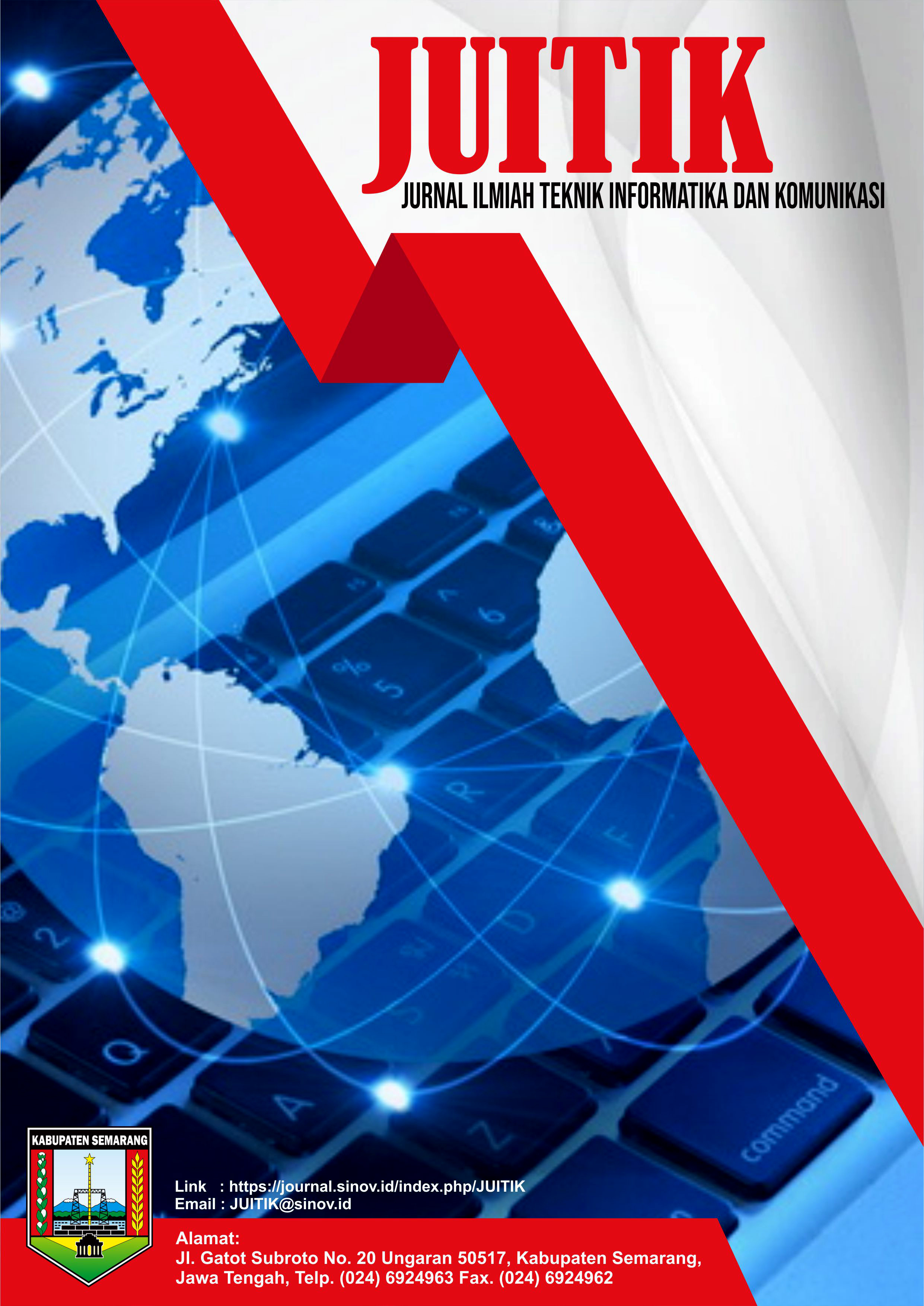Komparasi Algoritma Machine Learning (SVM, Random Forest, dan Regresi Logistik) untuk Prediksi Tingkat Obesitas
DOI:
https://doi.org/10.55606/juitik.v5i3.1716Keywords:
Logistic Regression, Machine Learning, Obesity Classification, Random Forest, SVMAbstract
Obesity is a global health issue with a continuously increasing prevalence. Early prediction of obesity levels is crucial for designing more effective intervention strategies. This study aims to apply and analyze the performance of three machine learning classification methods: Support Vector Machine (SVM), Random Forest (RF), and Logistic Regression (LR), for predicting obesity levels. The research methodology utilizes a public dataset, ObesityLevels, downloaded from the Kaggle platform, which consists of 2111 medical and lifestyle records. The process includes data preprocessing to convert categorical features into numerical ones, splitting the data into training and testing sets with a 70:30 ratio, model training, and evaluation using accuracy, precision, recall, and F1-score metrics. The results indicate that the Random Forest (RF) algorithm achieved the highest performance, with an accuracy of 90.3%, precision of 90.3%, recall of 90.3%, and an F1-score of 90.3%. Based on these findings, it is concluded that the Random Forest model is the most effective choice for an obesity level prediction system based on the dataset used.
References
Ar Rafiq, A., Sutono, & Lukman Wicaksana, A. (2021). Pengaruh aktivitas fisik terhadap penurunan berat badan dan tingkat kolesterol pada orang dengan obesitas: Literature review. Jurnal Keperawatan Klinis Dan Komunitas, 5(3), 167-178. https://doi.org/10.22146/jkkk.60362
Arifani, S., & Setiyaningrum, Z. (2021). Faktor perilaku berisiko yang berhubungan dengan kejadian obesitas pada usia dewasa di Provinsi Banten tahun 2018. Jurnal Kesehatan, 14(2), 160-168. https://doi.org/10.23917/jk.v14i2.13738
Ariyanto, Fatmawati, T. Y., Chandra, F., & Efni, N. (2023). Perilaku mahasiswa dalam pencegahan obesitas di STIKes Baiturrahim Jambi. Jurnal Akademika Baiturrahim Jambi (JABJ), 12(1), 201-206. https://doi.org/10.36565/jab.v12i1.696
Banjarnahor, R. O., Banurea, F. F., Panjaitan, J. O., Pasaribu, R. S. P., & Hafni, I. (2022). Faktor-faktor risiko penyebab kelebihan berat badan dan obesitas pada anak dan remaja: Studi literatur. Tropical Public Health Journal, 2(1), 35-45. https://doi.org/10.32734/trophico.v2i1.8657
Dikko, M. U., Hussaini, U., Alkali, Z. A., Bandiya, M. A. M., & Abdullahi, M. (24 C.E.). The moderating effect of corporate governance in the relationship women owned enterprises: A proposed conceptual framework. Fudma Journal of Management Sciences, 6(2), 167-186.
Emiliana, N., & Setiarini, A. (2024). Hubungan konsumsi minuman berpemanis dengan kejadian obesitas pada anak dan remaja: A systematic literature review. https://repository.unar.ac.id/jspui/handle/123456789/10983
Fatemeh Mehrparvar. (2024). Obesity levels. In Kaggle. Kaggle. https://www.kaggle.com/datasets/fatemehmehrparvar/obesity-levels/data
Fatmala, T., Rohmah, M., Maulidia Septimar, Z., & Tangerang, S. Y. (2022). The relationship of sweet beverage consumption with obesity in adolescents. Nusantara Hasana Journal, 2(1), 1-Page.
Fauzan, M. R., Sarman, Rumaf, F., Darmin, Tutu, C. G., & Alkhair. (2023). Upaya pencegahan obesitas pada remaja menggunakan media komunikasi. Jurnal Pengabdian Kepada Masyarakat MAPALUS, 1(2), 29-34. https://e-journal.stikesgunungmaria.ac.id/index.php/jpmm/article/view/39
Hanum, A. M. (2023). Faktor-faktor penyebab terjadinya obesitas pada remaja. Healthy Tadulako Journal (Jurnal Kesehatan Tadulako), 9(2), 137-147. https://doi.org/10.22487/htj.v9i2.539
Hidayah, N. A., Stikes, K., Cipta, B., & Purwokerto, H. (2022). Khasanah, N. A. H. (2022). Hubungan usia, jenis kelamin dan status obesitas dengan kejadian hipertensi di wilayah Puskesmas Sumbang II Kabupaten Banyumas. Jurnal Bina Cipta Husada, 18(1), 43-55.
Hita, I. P. A. D. (2020). Efektivitas metode latihan aerobik dan anaerobik untuk menurunkan tingkat overweight dan obesitas. Jurnal Penjakora, 7(2), 135. https://doi.org/10.23887/penjakora.v7i2.27375
Kurnia Saraswati, S., Dhista Rahmaningrum, F., Naufal Zidane Pahsya, M., Paramitha, N., Wulansari, A., Rossa Ristantya, A., Magdalena Sinabutar, B., Estetika Pakpahan, V., & Nandini, N. (2020). Media kesehatan masyarakat Indonesia literature review: Faktor risiko penyebab obesitas. Media Kesehatan Masyarakat Indonesia, 70-74. https://ejournal.undip.ac.id/index.php/mkmi https://doi.org/10.14710/mkmi.20.1.70-74
Mailoa, F. F. (2021). Analisis sentimen data twitter menggunakan metode text mining tentang masalah obesitas di Indonesia. Journal of Information Systems for Public Health, 6(1), 44. https://doi.org/10.22146/jisph.44455
Palechor, F. M., & de la Hoz Manotas, A. (2019). Dataset for estimation of obesity levels based on eating habits and physical condition in individuals from Colombia, Peru and Mexico. Data in Brief, 25, 104344. https://doi.org/10.1016/j.dib.2019.104344
Pengabdian, J., Jupe, M., Di, O., & Kendal, K. (2024). Program pengabdian masyarakat untuk mengatasi. 1, 21-23.
Putri, R. N., Nugraheni, S. A., & Pradigdo, S. F. (2022). Faktor-faktor yang berhubungan dengan kejadian obesitas sentral pada remaja usia 15-18 tahun di Provinsi DKI Jakarta (Analisis Riskesdas 2018). Media Kesehatan Masyarakat Indonesia, 21(3), 169-177. https://doi.org/10.14710/mkmi.21.3.169-177
Ramadhani, I. C., & Djamaluddin, S. (2024). Pengaruh konsumsi jadi dan olahan terhadap obesitas di Indonesia. Jurnal Informatika Ekonomi Bisnis. https://www.infeb.org/index.php/infeb/article/view/974
Suha Ghina Raniya, & Rosyada Amrina. (2022). Faktor-faktor yang berhubungan dengan kejadian obesitas pada remaja umur 13-15 tahun di Indonesia (analisis lanjut data Riskesdas 2018). Ilmu Gizi Indonesia, 06(01), 43-56. https://doi.org/10.35842/ilgi.v6i1.339
Sumarni, S., & Bangkele, E. Y. (2023). Persepsi orang tua, guru dan tenaga kesehatan tentang obesitas pada anak dan remaja. Healthy Tadulako Journal (Jurnal Kesehatan Tadulako), 9(1), 58-64. https://doi.org/10.22487/htj.v9i1.658
Veron, W. J., & Muhammad, S. (2022). Penerapan metode naive bayes dalam mengklasifikasi tingkat obesitas pada pria. JOISIE Journal Of Information System And Informatics Engineering, 6(2), 69-77.
Zahari, Q. F., Prashanti, N. A. S., Salsabella, S., Jumiatmoko, J., Hafidah, R., & Nurjannah, N. E. (2022). Kemampuan fisik motorik anak usia dini dengan masalah obesitas. Jurnal Obsesi: Jurnal Pendidikan Anak Usia Dini, 6(4), 2844-2851. https://doi.org/10.31004/obsesi.v6i4.1570
Downloads
Published
How to Cite
Issue
Section
License
Copyright (c) 2025 Jurnal Ilmiah Teknik Informatika dan Komunikasi

This work is licensed under a Creative Commons Attribution-ShareAlike 4.0 International License.










